In this post, we’re going to show you exactly how to choose a last mile carrier.
In fact:
These are the same strategies our clients use to partner with final mile carriers.
And deliver 10,000+ orders to their customers each month.
So if you want to:
- Get the best last mile carrier for the best price
- Quickly raise your last mile delivery capacity
- Provide more delivery options and grow at scale
- Turn more orders into successful deliveries
We’re going to show you how to do exactly that right now, step-by-step.
Let’s dive right in.
What Is a Last Mile Carrier?
A last mile carrier is a company that handles the final delivery of goods from fulfillment centers, depots or warehouses to the customer’s doorstep or an assigned delivery point.
These companies provide any type of order fulfillment services. This includes post and parcel, local and regional couriers, and direct delivery from fulfillment centers, especially for online stores and companies like Amazon and Walmart.
Simply put:
Carriers are responsible for the last mile, or the final leg of delivery: ensuring orders and packages reach end consumers.
Types of Last Mile Carriers
Carrier companies can be categorized based on their business model, service level that they provide, geographic coverage, method of delivery, and the types of products that they deliver.
Here’s a breakdown of common last mile carriers types:
1. Based on Business Model
- In-House Delivery Fleets: Retailers or businesses that own and operate vehicles, staff, and equipment to handle last mile delivery internally.
- Post and Parcel Delivery: Traditional postal services that allow businesses to send and receive packages to customers from the post office. Some post and parcel companies also provide limited pick-up at location. For example, USPS offers scheduled pick-up for domestic mail and package delivery.
- Third-Party Logistics (3PL) Providers: Companies that offer a wide range of logistics services, including all the different aspects of the supply chain: from warehousing and storage, to shipping orders to customers and managing returns with reverse logistics. 3PLs enable businesses to outsource their entire last mile delivery.
- Delivery Platforms: Online platforms that connect businesses with last mile carriers. These companies collect offers from different carriers on one site to provide a wide selection of delivery options, enabling businesses to compare and choose the best delivery service based on price and their requirements.
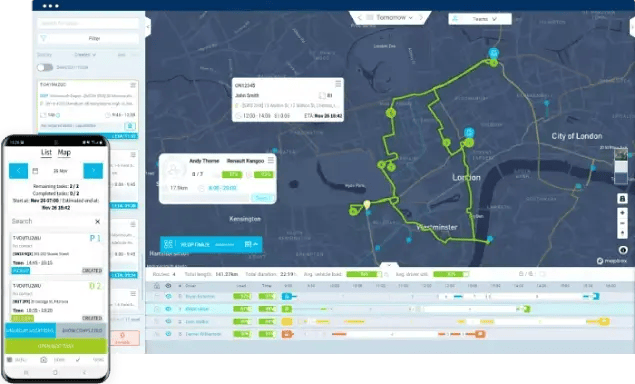
2. Based on Service Level
- Curbside Delivery: Orders are dropped off at the curb or the customer's doorstep.
- Threshold Delivery: Orders are delivered inside the house or office.
- Choice Delivery: Orders are delivered to a designated room inside the home.
- Locker Delivery: Orders are dropped off to a locker at the delivery point that’s provided by the carrier.
- White Glove Delivery: A specialized service that involves delivering orders inside the home by professionals who install and remove packaging materials.
3. Based on Geographic Coverage
- Local Carriers: Carrier and courier companies that handle deliveries within a small service zone. Local providers can service an area as small as a neighborhood or city, to as large as a country.
- Regional Carriers: Companies that deliver goods within a specific geographic region. This can refer to a region within a country (e.g. North England, Scotland, etc.), or delivery zones that cover multiple countries and states (e.g. EU, Midwest, etc.).
- International Carriers: Companies that deliver goods for you to different countries and worldwide.
4. Based on Delivery Methods
- Van or Truck Delivery: Using vehicles to drop off orders to customers. This is the most common method used by last mile carriers.
- Bike or Motorcycle Courier Delivery: This method is typically used for urban delivery or to expedite delivery in densely populated areas with high traffic congestion.
- Drone Delivery: A new method of delivery using drone technology for faster and more efficient delivery, especially in high-tech cities and to remote or rural areas.
- Automated Delivery Systems: Automated systems for package pick-ups that reduce the number of deliveries (e.g. lockers, click and collect, etc.)
5. Based on the Types of Goods Delivered
- Less-than-truckload (LTL): Carriers that handle small shipments that don’t require a full truckload. It’s a cost-effective way for businesses to deliver small order volumes.
- Specialized Carriers: Carriers that handle specific types of goods like food, building materials, pharmaceuticals, or electronics. To do this, these companies use specialized vehicles and equipment, like temperature-controlled trucks. This also helps with meeting safety and transport regulations.
Examples of Final Mile Carriers
- FedEx, UPS, DHL: Leading global carriers that provide a wide range of delivery services for both freight, package shipments, and logistics.
- USPS, Royal Mail: Traditional postal service providers that offer mail and package delivery to businesses and individuals.
- China Post, DTDC, SF Express: Regional carriers that handle last mile delivery in their markets (China, India).
- Amazon Logistics: Amazon’s in-house delivery service with its own network of drivers that handles order fulfillment.
- Amazon Flex: While it’s not a typical example, Amazon Flex integrates with other carriers to outsource and expand the delivery network of Amazon Logistics.
- Uber, Postmates: Last mile companies that offer on-demand delivery by using crowdsourced delivery to contract independent couriers.
- Grubhub, Doordash, Deliveroo: Carriers known for food delivery that use their delivery platforms to deliver meals to customers on demand.
- Shipt: A carrier that was acquired by Target in 2017 to provide same-day delivery from their stores.
- Nuro: A last mile startup that’s focusing on delivery using autonomous vehicles and automation of the process.
- eLogii: A platform that provides route optimization, real-time driver tracking, and delivery automation to last mile carriers.
- Dark Stores: Typical retail stores that are repurposed as a micro-fulfillment center to specifically handle online orders from e-commerce businesses (without public browsing).
- Crane Worldwide Logistics: A global 3PL that provides freight management and logistics with key focus on providing agile last-mile solutions.are a lot of examples of last mile carriers on the market.

Why Last Mile Carriers work for businesses in 2025
Using carriers gives you access to an existing delivery network. This can help your business provide fast and reliable services in the final phase of delivery.
This will be convenient both for you and your customers. (Especially, if you don’t have or want to invest significant capital upfront to build your own fleet to handle deliveries.)
Here’s a breakdown of several other benefits to using last mile carriers in 2025:
#1 No Upfront Cost
- No Need for Upfront Capital: Because you're essentially outsourcing your delivery to a carrier, you won’t have to invest money into building a fleet or its support network.
- No Need to Hire Staff: When you hire a last mile carrier in 2025, most companies can integrate with your point of sale to handle the deliveries without your active involvement.
#2 Faster Time to Market
- Offer Delivery Right Away: Because carriers have an existing delivery network, all you need to do is hire them to get your delivery service off the ground.
- More Time to Focus on Growth: Without the need to build a delivery service in-house, you can shift focus on developing other aspects of your business, like expanding it.
#3 Cost Savings
- Lower Shipping Costs: Using carriers to fulfill orders for you can help you to minimize shipping and handling costs in the short term. This is especially true if you’re just starting out, or if you can take advantage of volume discounts and long-term commitment deals.
- Labor Costs: No in-house delivery fleet = no delivery drivers, dispatchers, and other support staff = no labor costs. Pretty straightforward.
- Vehicle Maintenance and Fuel Costs: Last mile carriers help you avoid the operating costs of running and maintaining a delivery fleet. This includes variable, big ticket items that drive transportation costs up, like fuel consumption and vehicle maintenance.
#4 Higher Delivery Efficiency
- Streamlined Operations: Last mile carriers can help your business to streamline the delivery process by reducing the time and resources it takes for delivery.
- Automation: Most carrier and courier companies leverage technology, to enhance delivery efficiency and ensure good customer service. Tools like automated customer notifications and route optimization software.
- Route Optimization: Most last mile carriers, in-house deliveries, and hybrid fleets today use route optimization software to track, manage, and analyze their operations to make them more efficient.

- Data-Driven Decisions: By leveraging route planning tools, last mile carriers can provide valuable data and insights on their performance. This can help you to stay on top of day-to-day activities, but also make smarter decisions for continuous optimization and efficiency.
- Meeting Demand: Using a last mile carrier makes it easier for your business to scale delivery depending on consumer demand. When seasonal demand is high, you can quickly scale up to fulfill higher order volumes. While in the off season, you can scale back to cut costs.
#5 Customer Experience
- Faster Delivery: Hiring carriers can help you to increase delivery speed, because you’re relying on a tried and tested delivery network. This has a positive impact on customer satisfaction, since consumers are always looking to get their orders delivered as fast as possible.
- Convenience: Having the infrastructure and resources of your chosen last mile carrier at your disposal means you can provide multiple delivery options to your customers. This makes it much more convenient for them to buy and order goods from your business.
- Transparency: Many carriers provide real-time tracking and delivery updates. Allowing your customers to see where their order is gives them control and reduces the anxiety typically associated with delivery.
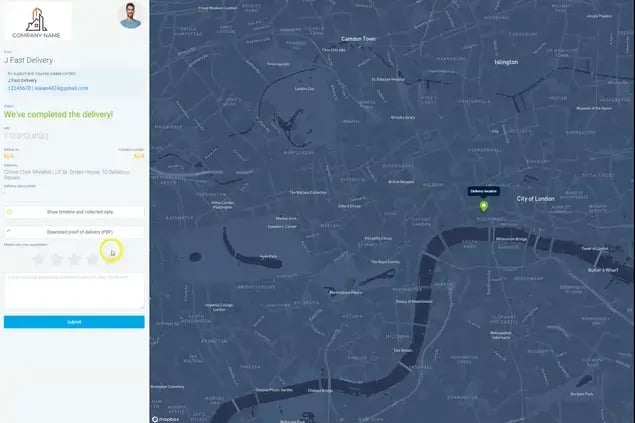
#6 Better Brand Reputation
- Seamless Delivery: A positive delivery experience has a HUGE impact on customer satisfaction. Letting a reliable carrier handle deliveries for you can help with that perception of your brand.
- Brand Protection: Due to their experience and service offers like scheduled delivery with dedicated delivery windows, last mile carriers ensure successful order fulfillment. This protects your customers from failed or missed deliveries, and your brand from negative feedback.
- Increased Sales: Customer satisfaction has a direct impact on repeat purchases, which raises their lifetime value. (Which leads to more revenue for your business.)
#7 Other Benefits
- Access to New Markets: The vast resources and delivery network of last mile carriers can help your business to reach more customers in new and remote areas.
- Customized Solutions: Most carriers offer custom and white-label services that allow you to provide delivery services that meet your business goals and protect your brand.
- Proof of Delivery: Carrier companies provide proof of delivery (POD) to ensure delivery success and customers’ piece of mind, but also to help you to resolve delivery disputes.

Why Last Mile Carriers might not work for your business
Let’s be clear:
Last mile carriers work. And many businesses use carriers instead of building an in-house fleet.
But it’s not without shortcomings. Factors like higher delivery costs, lack of control, and poor visibility might mean that it’s not the right path for your business.
To help you, here’s a detailed overview of why last mile carriers might not benefit your business:
- Higher Cost of Delivery: While hiring a carrier doesn’t require upfront investment, the price of delivery is higher than operating an in-house fleet. So, in the long term it’s more expensive, despite fuel, labor, vehicle maintenance, and other costs. All of that is always included in the service fee you pay.
- Limited Control: Hiring a last mile carrier means they’re responsible for fulfilling an order on the behalf of your business. But you have little or no control over how they do it, including route planning, delivery scheduling, and driver behavior. This can lead to potential delays or missed deliveries.
- Complex Communication: Outsourcing last mile delivery to a carrier adds an extra level of complexity to communication between you and your customer, regarding their order. If this process isn’t streamlined, it can be frustrating to you as a business owner. While poor communication at any level can have a negative impact on customer trust.
- Lack of Accurate Tracking: Despite leveraging technology, you don’t have a say in what tools carriers use to track drivers and deliveries. How can you or your customers know that their delivery status or estimated times of arrival (ETAs) are accurate? So, there is a big issue with real-time visibility over your delivery operations.
- Late or Damaged Deliveries: Without control over driver performance and behavior, you don’t know what kind of person is delivering to your customers. This may lead to late, damaged, or even missed deliveries, which can negatively affect the reputation of your business.
- Driver Availability: Choosing a carrier with a small fleet and limited delivery network and other resources at their disposal can lead to driver shortages. This can have a huge effect on their ability to scale or even handle high order volumes when your business is experiencing a spike in demand.
- Brand Visibility: Outsourcing to a last mile carrier always means lower visibility of your brand. This is true simply because that company is handling order fulfillment with their own branded vehicles and drivers.
Outsourcing your delivery to a Last Mile Carrier: Pros and Cons
Here’s a quick breakdown of the pros and cons of using a carrier:
Should you hire a Last Mile Carrier?
|
Pros
|
Cons
|
- No upfront capital requirements. You pay a fee as you use the service.
|
- You can encounter hidden fees
|
- Lower operating costs of owning delivery service initially.
|
- Higher cost per delivery overall, which makes it more expensive in the long term.
|
- Faster time to market with your delivery.
|
- Lower sustainability over time.
|
- No labor or vehicle maintenance costs.
|
- Hidden fees may apply to some services.
|
- Full access to resources: experienced drivers, vehicles, delivery automation, route optimization, and data-driven analytics.
|
- Lack of control over operations, the delivery process, and the use of resources.
|
- Easier to scale operations to meet higher demand or access new markets.
|
- Driver availability can be an issue with smaller carriers.
|
- Faster and more convenient delivery can have a positive impact on brand reputation.
|
- Delivering goods under a different logo can confuse customers and lower brand visibility.
|
- Many carriers provide real-time tracking and delivery updates to be transparent.
|
- Tracking accuracy is lower than if you monitor performance in house.
|
- Custom solutions can improve customer experience and increase sales through repeat purchases.
|
- Complex and poor communication can lead to damaged goods, missed delivery windows, and even failed deliveries.
|
How to choose a Last Mile Carrier for your business
In this part of the article, we’ll walk you through each step of the decision-making process of how to select the right final mile carrier.
We’re going breakdown this part of the article into:
Let’s get started.
Which Last Mile Carrier model is right for your business?
The first step when choosing a last mile carrier model that fits your business is to determine your delivery volumes.
Or, how many deliveries you handle in a specific period.
Let’s take your average number of deliveries per month:
Add up the total # of deliveries in a year, and divide it by 12 months.
That’s it.
Of course, this is a rough estimate.
Meeting seasonal demand in November and December will require a different approach than the slower season in July and August.
But this isn’t the only thing you have to consider.
So now, we’ll show you three different last mile carrier models.
Each with its own benefits and pitfalls according to your business.
#1 Working with a single carrier
For most businesses, this is their main choice when looking for a last mile carrier provider.
Working with a single fleet carrier is relatively easy. It’s also more convenient in terms of:
- Tracking: you don’t have to monitor the performance of multiple drivers
- Communication: you typically have a dedicated person for your account
- Integrations: you connect your systems to a single channel
- Planning: you can quickly schedule pick-ups for delivery and in advance
You can also rely on small local last mile delivery service providers.
In many cases, this can lower your overall delivery costs. While working with local drivers ensures a positive delivery experience for your customers.
The downside of using a single carrier is that they often have a limited fleet capacity.
In high-demand seasons, carrier fleets have a harder time keeping up with order volumes.
With smaller last mile carriers, this is particularly true.
And if that’s the case, your customers will suffer the most. (And with them, your reputation)
Using multiple last mile carriers to handle deliveries gives your business:
- Flexibility: it’s easier to scale up or down fleet sizes depending on delivery volumes
- Unlimited capacity: you can hire as many carrier fleets as needed to fulfill all orders
- Better returns policies: you can handle both forward and reverse logistics
- Speed: you can dispatch deliveries to the best suited or closest carrier or driver
- Control: you prioritize what’s important to you: speed, shipping costs, green logistics
- Visibility: with a delivery platform, it’s easier to track progress and performance
But to achieve all of this, you do need a delivery management platform like eLogii.
These tech stacks have modules ideal for fleet dispatching and management.
This enables you to create virtual carrier fleets with individual driver profiles which makes it easier to plan and schedule deliveries, even in a dynamic environment or on the go.
You also have the benefit of using the delivery software with a crowdsourced delivery.
This allows you to build an agile fleet - a hybrid last mile carrier model where a main carrier handles most deliveries and several crowdsourced agents stay on stand-by, for the busier times of the day.
The only downside to using multiple carriers is that if you have never used delivery software, it may take you some time to get comfortable with it.
#3 Working with a 3PL
The biggest benefit of working with a 3PL (third-party logistics provider) is that you can have multiple fleets without managing the logistics by yourself.
This makes it easier to handle deliveries and meet expectations, regardless of your delivery volume or specific needs.
That’s why this last mile carrier model is ideal for dropshipping and similar hands-off models.
It’s also easier to customize commercial contracts with a 3PL. This may help you to:
- Lower delivery costs with options like flat-rate shipping
- Scale up or down the workforce (and delivery costs)
- While-label the delivery fleet to represent your brand
- Take advantage of otherwise unavailable technologies
Typically, this does mean that you won’t just hire the fleet and drivers.
You also cover the expenses associated with supporting services and staff, which does raise last mile delivery costs.
Plus, you lose a lot of control over the delivery process. And some 3PLs may not be able to accommodate all your needs in terms of speed and visibility.
Key considerations when choosing a Carrier for your Last Mile Delivery
#1 Last mile carrier tracking
Tracking last mile carriers is crucial in three key areas:
- Progress monitoring
- Performance tracking
- Customer experience
That’s why last mile tracking can refer to:
Shipment tracking or order tracking gives you real-time visibility over the fulfillment process by tracking events in the delivery lifecycle. This helps you to gain insight over the progress over each delivery.
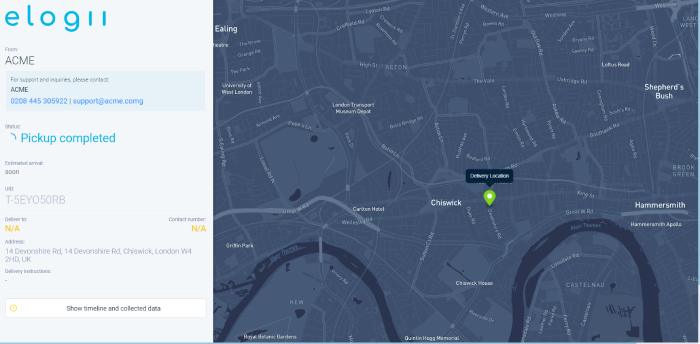
Sharing order tracking information with customers lets them check the delivery status of their orders and greatly improves their experience.
Last mile carrier tracking gives you visibility over each carrier fleet or individual drivers and their location in real-time.

This enables you to monitor performance to ensure efficiency, prevent late and failed deliveries.
Tracking data also helps you to schedule second and third delivery attempts or returns in real-time. Or analyze historical data to measure the performance of a carrier.
This feature is accepted by last mile carriers as one of the most requested features from service users.
For both B2C and B2B delivery, this means having the right last mile tracking technology in place.
This ensures the tracking information is accurate and reliable. And that all customers have a positive experience.
#2 Different service levels
When picking a last mile carrier to work with, take notice of their services.
Every business has different last mile service requirements. The carrier you end up choosing has to reflect those needs by letting you pick and choose and customize their services.
In that way, they’ll provide exactly the services you’re looking for.
For example, a customized service level may let you configure multiple different delivery options that you want to offer to customers. Everything from same-day delivery to curbside delivery.
#3 Different last mile delivery options
Let’s face it:
People want convenient, safe, and fast delivery.
In fact, convenience and delivery speed are among the most important elements of a five-star delivery experience for 80% of consumers. (According to delivery statistics)
So, beside traditional multi-day delivery options from storage facilities, you should also consider:
#1 Ship from store vs. ship from hub services: If you don’t have a warehouse, carriers have to support your ship-from-store model.
#2 Same-day + on-demand delivery options: If you want to provide fast and on-demand delivery to customers, you have to look for last mile carriers that can accommodate your needs. Or search for multiple carriers that can cover your entire service area.
#3 Point to point pick-ups or batching: You should look for last mile carriers that provide both. Picking up one order at a time is ideal if you want to fulfill same-day deliveries. Batching is a more budget-friendly option. Make sure that the carrier charges you a cumulative price, rather than per delivery.
#4 Easy integration with delivery services
Delivery businesses rely more and more on technology.
The last mile carrier you choose has to work using technology that can integrate with your systems and tech stacks.
This means being able to accommodate on-premise integration. Or better use a powerful API to integrate with any system remotely.
Make sure the last mile carrier technology can integrate with your:
- Order management system
- Warehouse management solution
- Communication apps
- Customer service software
Additionally, ask whether they provide on-call support during the integration process.
#5 Delivery and shipping costs
Lower delivery costs is always a HUGE factor when picking a last mile carrier. But it’s not the only factor to consider.
When discussing price with a carrier, compare the pricing on each delivery service you want to offer.
Standard delivery may be more affordable with one provider. But the same carrier may have the most expensive price for next-day shipping.
You should also see how you will be charged. Whether it’s a fixed monthly fee with a limited number of deliveries. Or an unlimited contract where you’ll be charged per delivery.
#6 Fleet, driver, and delivery capacity
Determining the fleet capacity helps you know the order volumes a particular carrier can handle.
Besides the size of the fleet, check what kind of vehicles they use. There’s no point in hiring a carrier, if their vehicles break down and drivers miss deadlines or fail to fulfill orders.
The same goes for drivers. Make sure that the carrier has enough drivers on call to guarantee delivery on all orders.
#7 Use of last mile delivery technology
Want to choose the right last mile carrier for your business?
Focus on technology. Why?
Last mile delivery technology helps you to tackle complex logistics and raise capacity to handle more deliveries and returns.
In fact, nearly every other company (or 46%) that uses technology has seen significant or moderate help getting large delivery volumes out to customers during the pandemic.
In other words, you can deliver more with technology. And you can do it easier.
Using software also raises efficiency and helps you to provide an amazing delivery experience.
Here’s how:
- You can integrate real-time quotes with the carrier and your online store
- You can’t raise efficiency, delivery speed, or capacity without capital investment
- You can use route optimization to raise stop density to lower the cost of delivery
- You can use real-time tracking to generate last mile visibility for you and your customers
- You can use software to collect, analyze, and evaluate data to track KPIs over time
- You can take advantage of innovative technology like AI and machine learning
So ask a potential last mile carrier what technology they use.
And make sure that it’s easy to integrate other software solutions.
That can help you to take your delivery service to the next level.
#8 Customer and delivery experience
If you want to win more customers with your delivery, you have to focus on their experience.
Besides real-time carrier tracking, the carrier should also be able to offer your customers:
- Delivery scheduling: 53% of online shoppers in the US won’t buy a product if they can’t pick and choose the delivery date. So when selecting a last mile carrier, make sure that they allow your customers to pick delivery slots with a date (and even time) of arrival.
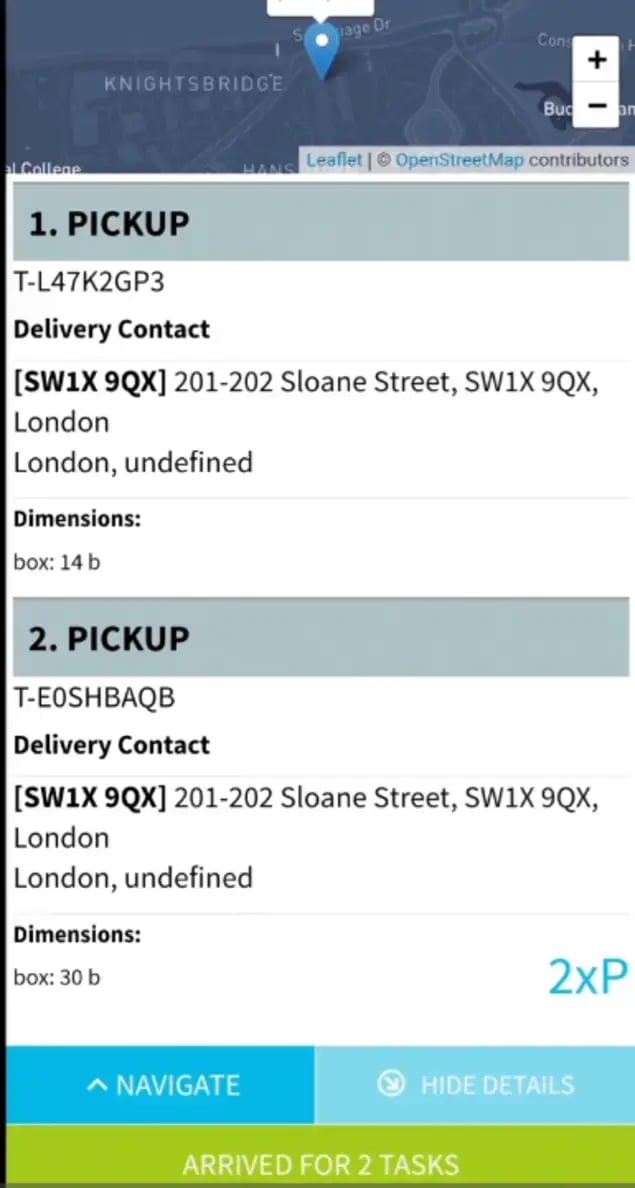
- Rescheduling: On average, 10% of all first delivery attempts fail worldwide. And 69% of consumers won’t shop again with a retailer if their orders don’t arrive on time. Carriers should account for this, and provide automated delivery rescheduling to improve customer experience and reduce your service costs.
- Customer notifications: 59% of customers in the United States expect to receive delivery alerts, notifications, and ETAs about the status of their order. Make sure that the carrier can support this, and that you can customize these messages in line with your brand.
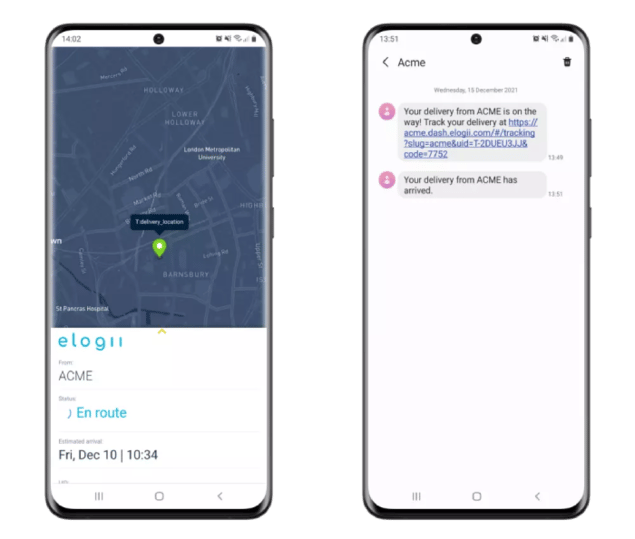
- SMS alerts: If the final mile carrier provides access to a delivery driver app to their fleet, make sure the drivers can use it to communicate with your customers.
- Customer reviews and ratings: A good last mile carrier isn’t afraid of allowing customers to give feedback and rate the delivery service and their experience.

Last Mile Carrier FAQ: 20 Questions to ask when hiring a carrierer
Ready to evaluate 3PLs and last mile carriers?
Before making your choice, be sure to ask these crucial questions:
#1: What is the size of your delivery fleet?
Ask the carrier about the number of vehicles and drivers they have available. Understanding the scale of the carrier's fleet and workforce ensures they can successfully handle your delivery volume now, and in the future as you grow your business.
#2: What delivery area does your fleet cover?
Confirm whether the carrier can cover your required geographic regions.
#3: Do you ship across borders (internationally or cross-state)?
Confirm that the carrier can handle international shipments and deliver across state lines.
#4: How do you charge for your services? Is it fixed or per delivery?
Discuss pricing models to find one that fits your budget and delivery needs. A fixed monthly fee for a certain number of shipments may work for you, but it’s limited. On the other hand, paying per delivery allows you to scale according to demand, but is typically more expensive.
#5: Do you offer commercial contracts? What are the benefits?
Ask about contract options and potential advantages like discounts or guaranteed service levels. This can provide additional cost-savings opportunities or amenities that can set apart carriers, and make your decision easier.
#6: Do you provide different service levels and service customization?
Ensure the carrier can offer customizable delivery options tailored to your business needs. This will help you to get the type of service you’re looking for.
#7: Can you accommodate multiple delivery options?
Check if the carrier supports various delivery methods that meet your customers' expectations. For example, if you own a retail store it makes sense to offer same-day delivery. It also allows you to offer choice to online shoppers on your checkout page.
#8: How do you integrate your delivery services with my business?
Learn about the technology and integration support provided to streamline operations. This helps you to know If you’ll have to schedule orders every time you want to ship a package, and whether the carrier can help you with that or you’ll have to hire a tech-specialist to assist you.
#9: What software do you use to manage deliveries?
Understand the technology used for route planning, tracking, and delivery management. Evaluating levels of automation can help you to determine how efficient the carrier’s services are, and how easy your workflow will be (scheduling pick-ups, reporting).
#10: Can your tech stacks integrate with my software?
Confirm compatibility with your existing systems and availability of support for the integration.
#11: How will I track deliveries? What kind of tracking do you provide?
Determine the level of tracking detail you’ll receive for better operational insight. Having access to basic order tracking capabilities helps you to see the status of each delivery. But accurate driver tracking can streamline operations by providing you with a greater level of detail in terms of driver location, pick-up and drop-off ETAs, vehicle capacity, and more.
#12: Do you provide automated delivery scheduling and rescheduling?
Check if the carrier offers flexible scheduling options to improve delivery success rates. It’s also good to know if you’ll have to hire someone to plan, schedule and dispatch orders and returns.
#13: Do you provide notifications and alerts? Can they be customized?
Ensure customers can receive timely updates and that messaging aligns with your brand. Make sure to ask how your customers will receive those messages (email, SMS, Viber, WhatsApp), and what stages will trigger them (order is processed, picked up, in transit, 5 minutes away).
#14: Do you provide white-labeling?
Ask if notifications and tracking links can be branded as your own. This helps you to maintain brand visibility even if you’re using a last mile carrier.
#15: How will my team communicate with your staff?
Understand how your employees will interact with the carrier personnel about managing daily activities and issues. Be specific and inquire about the channel you’ll use, and whether you’ll have a dedicated person for your account.
#16: Where do you pick up and ship orders from? Is it from store, warehouse, or fulfillment center?
Verify if the carrier supports your inventory distribution model. Ask if they’re willing to send drivers to pick up packages from all your facilities, or if you’ll have to have a dedicated location for pick up.
#17: Do you pick up per order or do you do delivery batching?
Learn about the pickup options and the carrier’s pricing models to optimize your costs. Ask about the cost to pick up and ship per order, or if you’ll have to dedicate a time window when the carrier will come to pick up all daily or weekly orders.
#18: What businesses use your services? What do they say about you?
Ask for references or testimonials to evaluate carrier reputation, and if they can meet specific needs of your products and industry. Alternatively, research the carrier online before you meet with them (Google Reviews, Yelp, and other business review sites).
#19: What’s your track record for on-time delivery and success rates?
Review carrier key performance metrics to ensure reliability. Request historical data that clearly shows on-time vs. late deliveries, no. of missed and failed delivery attempts, and other metrics that determine how successful they are.
#20: What is the first step I need to take to get started?
Clarify the onboarding processes to start the partnership smoothly. Find out what you need to do to get this process started, and the timeline to full implementation of the delivery service.
How to manage your last mile delivery when using a Carrier
Congratulations! You have chosen a last mile carrier and you can finally start delivering orders to customers.
But that’s the easy part.
You’ll now have to find a way to manage day-to-day operations, and keep track of the delivery workflow. That’s the hard part.
For that, you’ll need a tool to help you.
Enter: Route optimization software.
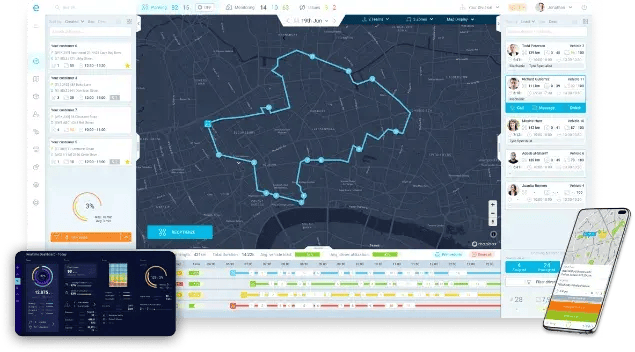
Even though you won’t be planning routes or taking a hands-on approach to how the carrier fulfills your orders, there are still several benefits to investing in the right tool to monitor their operation.
Here are a few examples of how route planning software like eLogii makes it easier to manage a last mile carrier fleet:
- Integrate Multiple Carriers: Whether you use a single carrier, 3PL, or multiple carriers in a hybrid model, you can integrate the software with all of them via the routing API.

- Get Access to More Resources: Integrating carriers on one platform leverages their combined resources in one place, and makes them available to you.
- Grow to Scale: Having all carriers in one place provides you with their combined delivery network. This makes it easy to expand your delivery zone and access new markets.
- Driver Availability: With more resources at your disposal, you don’t have to worry about missed deliveries due to unavailable drivers, even when demand is high. If one carrier can handle the workload, you can quickly re-assign deliveries to another carrier.
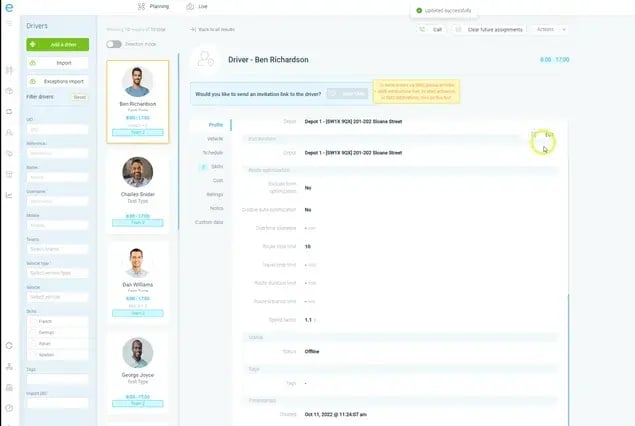
- Full Control Over Operations: With route optimization software like eLogii, you can treat carriers like an in-house delivery fleet.
It allows you to take on the responsibility of planning routes, scheduling deliveries, dispatching drivers, and managing operations end-to-end, to ensure delivery success.
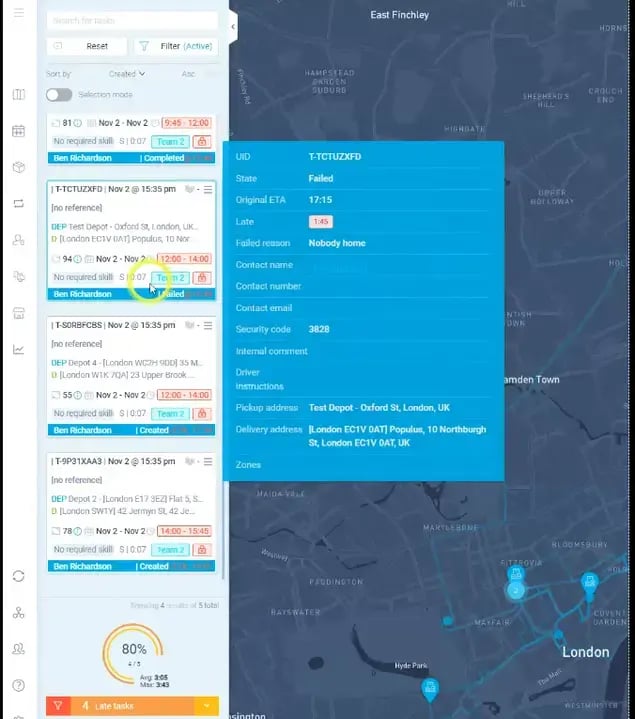
- Accurate Real-Time Tracking: eLogii has the best real-time tracking on the market. So investing in a system you’re sure that works gives you the confidence to send ETAs to customers and monitor driver performance using accurate data.
- Automated Communication: With routing software, you can set up automated alerts and notifications that provide tracking links and inform customers about the status of their delivery as it happens.
On the other hand, it streamlines communication with your chosen carrier, as you can dispatch orders to drivers directly via the driver app on their phones.
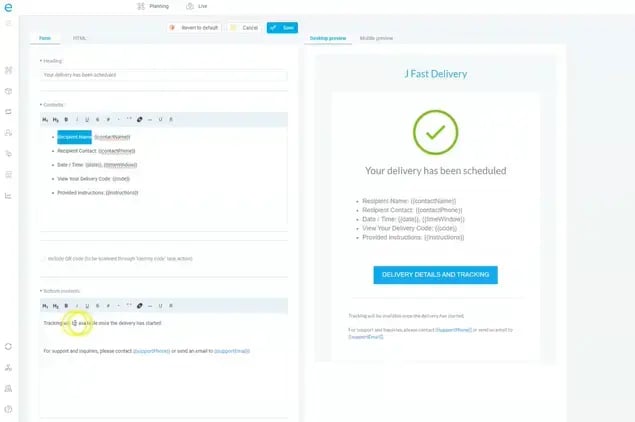
- Collecting Proof of Delivery: eLogii and other tools have ePODs built into the system. Not only does this give you first-hand proof an order is delivered (which prevents failed deliveries), but you can also choose what that is: signature, barcode/QR-code scan, photo verification.
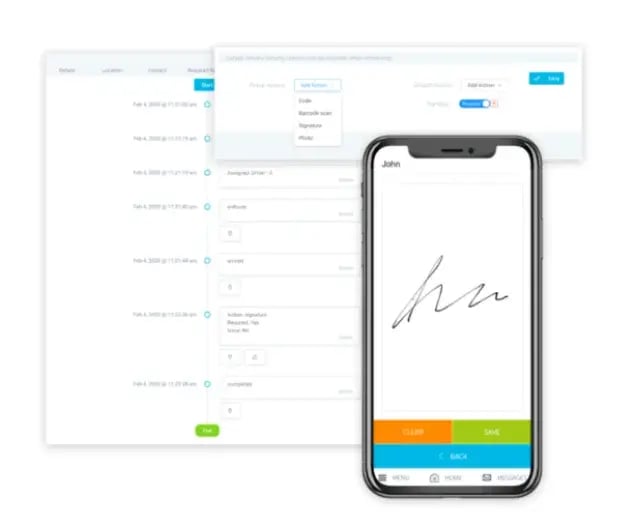

Ready to choose a last mile carrier?
Now you’re ready to evaluate your last mile carrier options.
And choose the right one based on YOUR business needs.
But if you need help with other areas of your delivery, we’re here to help.
![]()

![]()

![]()
![]()

![]()








